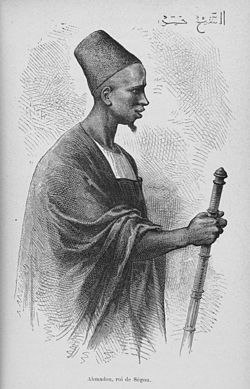| Ahmadu Sekou Tall | |
|---|---|
| Khalifa, Faama, Amir al-Mu'minin | |
 Ahmadu Tall, as portrayed by the French (c. 1880) Ahmadu Tall, as portrayed by the French (c. 1880) | |
| Reign | 1864-1893 |
| Predecessor | Umar Tall |
| Born | June 21, 1836 Sokoto Caliphate |
| Died | 15 December 1897(1897-12-15) (aged 61) Sokoto |
| Religion | Islam |
Ahmadou Sekou Tall (June 21, 1836 – December 15, 1897) (also Ahmadu Sekou, Ahmad al-Madani al-Kabir at-Tijani) was a Toucouleur ruler (Laamdo Dioulbé) of the Toucouleur Empire (1864–93) and (Faama) of Ségou (now Mali) from 1864 to 1884.
Biography
Ahmadu was born during his father El Hadj Umar Tall's stay in the Sokoto Caliphate. His mother was a Hausa slave.
Ahmadu Sekou's father conquered Ségou (then the heart of the Bambara Empire) on March 10, 1861. Not long afterwards, he began his conquest of the Fula empire of Massina, leaving Ahmadu as the Almami of Ségou.
Umar Tall died in 1864 attempting to suppress a rebellion in Massina. Ahmadu, the ruling Faama of Ségou and the eastern regions of the Toucouleur Empire, attempted to assert his control over the entire unit. He was opposed in this by his cousin Tidiani Tall, based in Massina, and later by his half-brothers Moktar and Aguibu Tall [fin]. His rule consisted largely of suppressing rebellions and fighting to centralize the empire against the resistance of the Fula aristocracy. To that end he cultivated a base of support among the Bambara natives of Segou.
The government was highly structured, with centrally appointed governors of the various provinces seconded by cadis, military commanders and tax collectors. Ministers based in Segou managed various portfolios such as justice, the Niger river fleet, the public treasury, relations with Europeans and other foreign powers, commerce, etc. For much of Ahmadu's reign his cousin Sydou Djelia served as prime minister.
Moktar and Aguibu attempted to use Nioro du Sahel and Koniakary as bases for independent power in the 1870s, but were both defeated and imprisoned. Ahmadu replaced them with another brother, Muntaga, who in turn rebelled in 1884. In suppressing that rebellion Ahmadu moved his court from Segou to Nioro.
Facing the advance of the French colonial army in the 1880s and 1890s, Ahmadu accepted a short-lived alliance with the French through the Treaty of Gouri on 12 May 1887. Ségou fell to the colonizers in 1890. The Toucouleur army, led by Ahmadu's Wolof ally Alboury Ndiaye, was defeated outside Nioro in January 1891. With Ndiaye, Ahmadu fell back eastwards to Djenne until its fall in 1893, then to modern-day Niger. Ahmadu reached Sokoto, now in present-day Nigeria, where he died in 1897.
Legacy
Ahmadu Tall was an enlightened and wise ruler, who treated French diplomats courteously. Although he was a Toucouleur, he has been remembered fondly by the Bambara of Segou over whom he ruled for nearly 30 years.
| Preceded byEl Hajj Umar Tall | Faama of Ségou 1864 - 1884 |
Succeeded byMadani Ahmadu Tall |
| Preceded byMuntaga Tall | Faama of Nioro 1884 - 1890 |
Succeeded byFrench West Africa |
| Preceded byMounirou Tall | Faama of Masina 1890 - 1892 |
Succeeded byFrench West Africa |
References
- ^ Encyclopædia Britannica. Vol. 1 (15th ed.). USA: Encyclopædia Britannica. 1991. p. 166. ISBN 9780852295298.
- Page 2005.
- ^ Imperato, James Pascal (1977). Historical Dictionary of Mali. Metuchen, N.J.: Scarecrow Press. p. 15. Retrieved 23 September 2023.
- Cissoko 1982, pp. 68.
- Cissoko 1982, pp. 69.
- Hanson, John H. (1985). "Historical Writing in Nineteenth Century Segu: A Critical Analysis of an Anonymous Arabic Chronicle". History in Africa. 12: 101–115. Retrieved 27 October 2023.
- Charles, Eunice A. (1977). Precolonial Senegal : the Jolof Kingdom, 1800-1890. Brookline, MA: African Studies Center, Boston University. p. 130. Retrieved 15 July 2023.
Sources
- Cissoko, Sekene Mody (1982). "Formations sociales et État en Afrique précoloniale : Approche historique". Présence Africaine. COLLOQUE SUR « LA PROBLÉMATIQUE DE L'ÉTAT EN AFRIQUE NOIRE ». Retrieved 4 July 2023.
- B. O. Oloruntimeehin. The Segu Tukulor Empire. New York: Humanities Press (1972). SBN 391002066
- Page, Willie F. (2005). Davis, R. Hunt (ed.). Encyclopedia of African History and Culture. Vol. IV (Illustrated, revised ed.). Facts On File. p. 14.